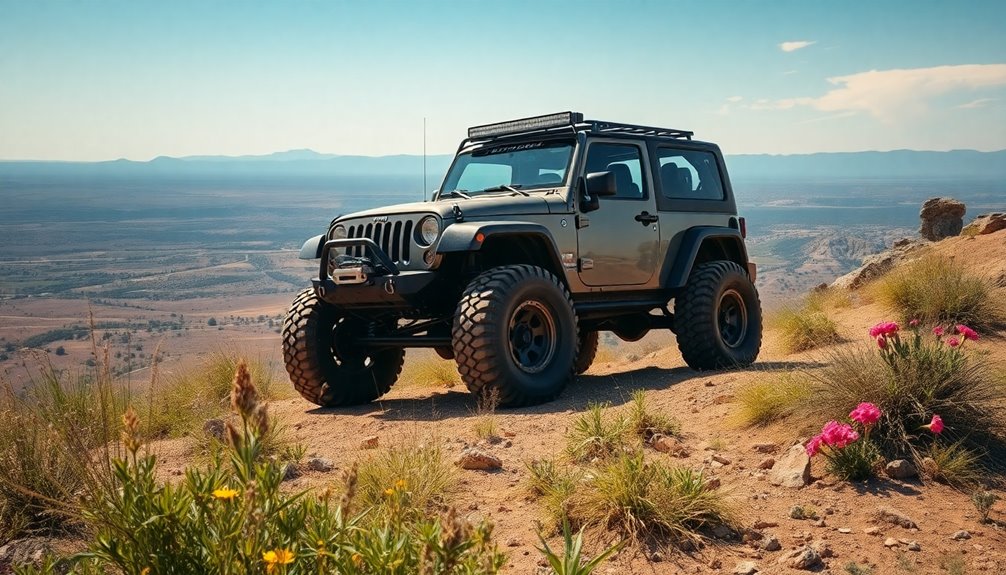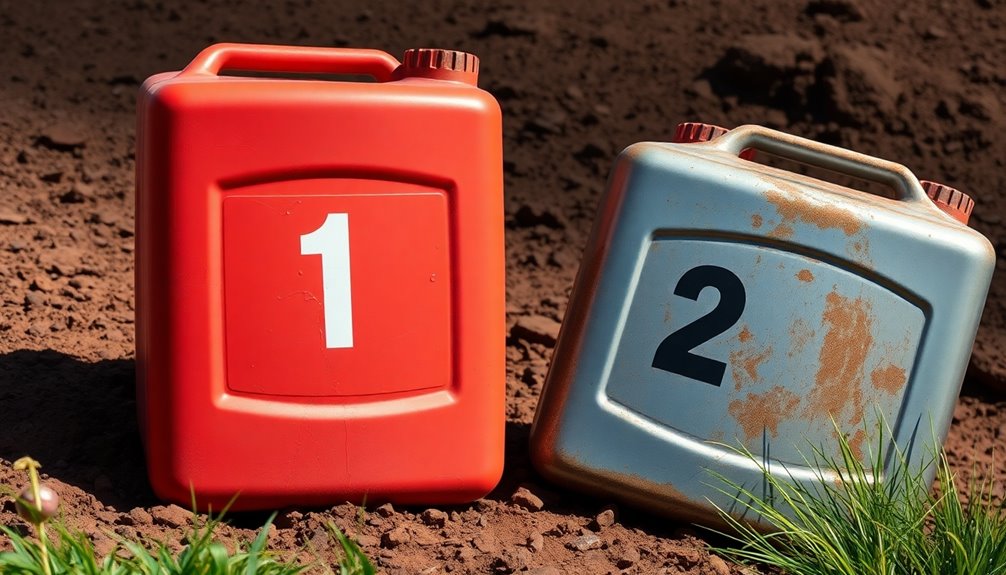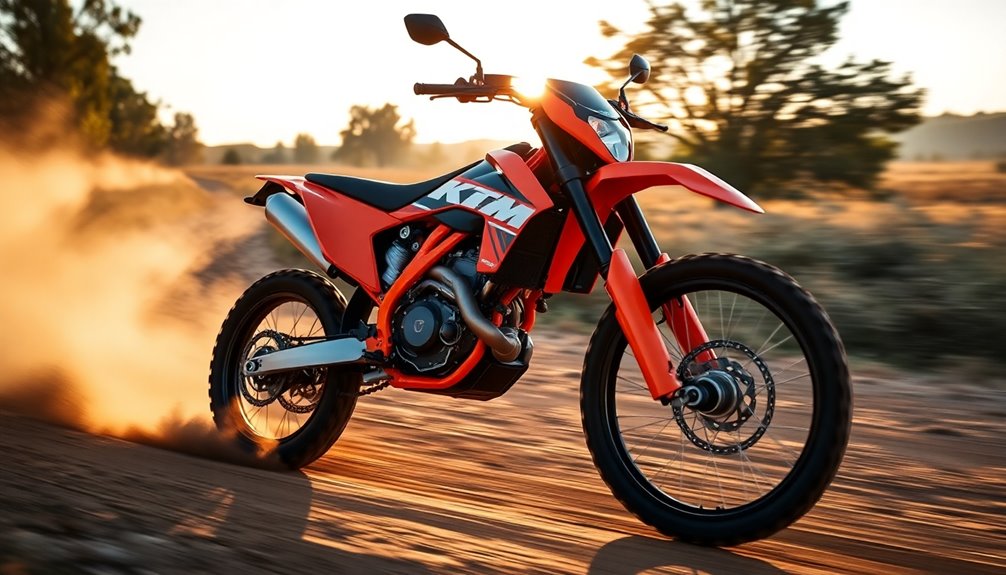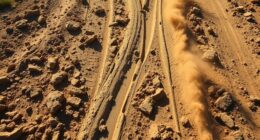A 125cc dirt bike typically hits top speeds of 55 to 60 mph, offering an exhilarating experience on various terrains. The speed you achieve can depend on factors like your weight, skill level, and the type of terrain you're riding on. Two-stroke engines generally provide better speed than four-stroke counterparts, so consider that when choosing a bike. Enhancements like weight reduction and performance upgrades can also help maximize your speed. Plus, maintaining your bike properly boosts performance. Stick around to discover how other riders optimize their rides and what modifications can elevate your dirt biking experience.
Key Takeaways
- The top speed of a 125cc dirt bike typically ranges from 55 to 60 mph, depending on rider skill and terrain.
- Two-stroke engines generally outperform four-stroke engines, providing higher speeds and better power-to-weight ratios.
- Modifications like engine tuning, upgraded exhausts, and lightweight components can enhance speed and performance.
- Maintaining optimal tire pressure (11-13 psi) and keeping the bike clean are crucial for achieving maximum speed.
- Rider technique, including throttle control and body positioning, significantly impacts speed and overall riding experience.
Engine Type and Displacement
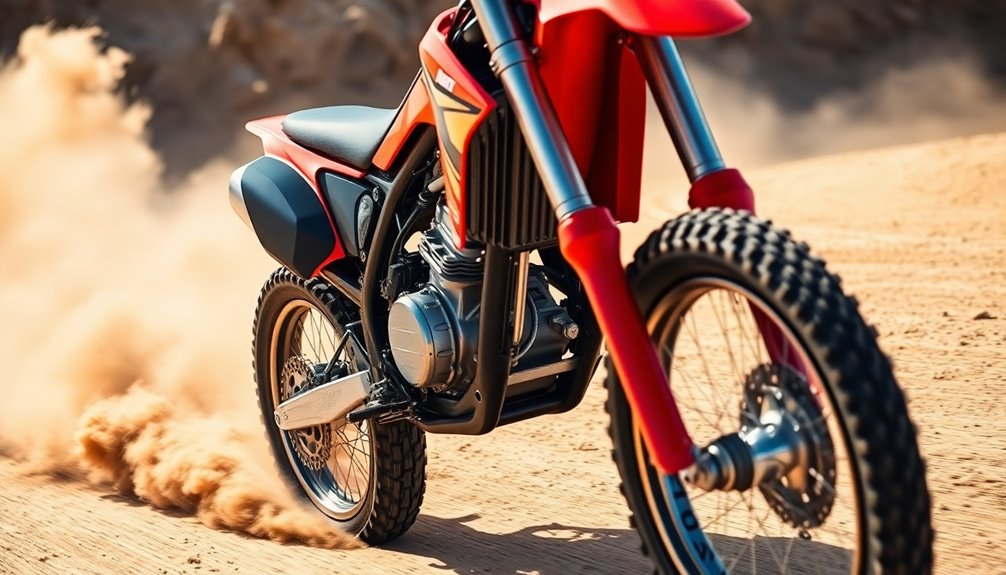
When it comes to 125cc dirt bikes, the engine type and displacement play a crucial role in determining performance.
You'll find two main engine types: two-stroke and four-stroke. Two-stroke engines complete a power cycle in one crankshaft revolution, making them smaller and lighter with fewer moving parts. This means they offer a powerful punch, often making a 250cc two-stroke comparable to a 500cc four-stroke. However, they require a gas and oil blend and tend to pollute more, despite recent improvements.
On the other hand, four-stroke engines deliver power smoothly over two crankshaft revolutions, which translates to quieter rides and a steadier feel. While they're heavier and have more moving parts, they require less maintenance and only need plain gasoline. Additionally, engine size is crucial for overall performance, as it influences both power delivery and handling characteristics.
Displacement is another factor to consider. Generally, larger engine displacement means more power and higher top speeds. A higher CC engine can handle demanding conditions better.
Performance Metrics Breakdown
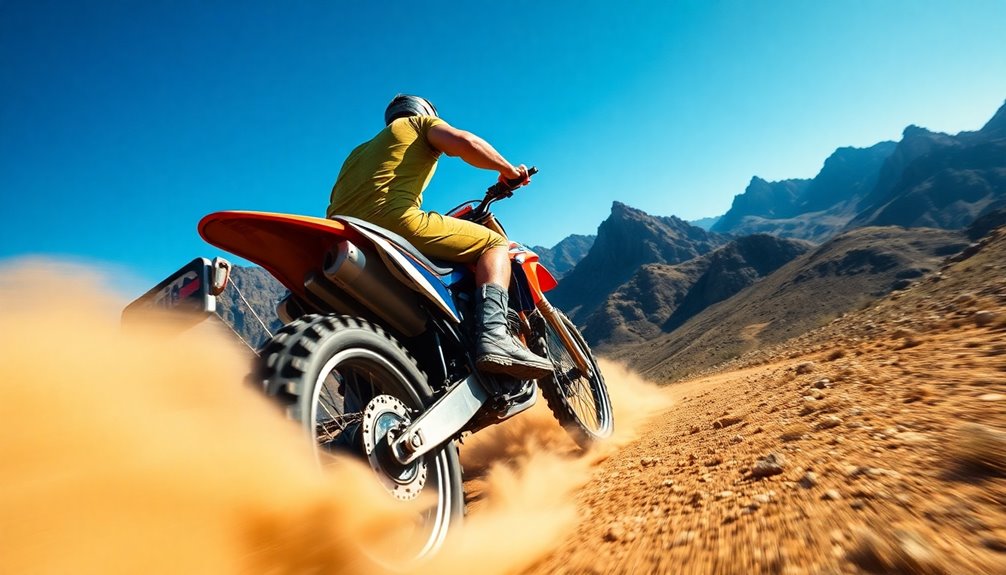
When you evaluate a 125cc dirt bike's performance, it's essential to consider maximum velocity achieved, throttle response time, and tire grip and condition. These metrics greatly impact your riding experience and can influence how well you handle different terrains. Understanding these factors helps you make the most of your bike's capabilities. Additionally, keep in mind that a higher CC engine generally offers increased power output, which can enhance both speed and acceleration.
Maximum Velocity Achieved
Understanding the maximum velocity achieved by a 125cc dirt bike involves breaking down several performance metrics that play a crucial role in speed. Typically, you can expect a top speed between 55-60 mph, depending on various factors. The engine type significantly impacts speed; two-stroke engines generally outperform four-stroke engines.
The power-to-weight ratio is essential as a higher power output relative to your weight enhances speed. Aerodynamics also matter—minimizing wind resistance can lead to better performance, especially on smoother terrains. Additionally, engine displacement (cc) directly correlates with bike speed capabilities, meaning larger engines generally provide more power and speed.
Adjusting transmission and gear ratios optimizes speed for different riding conditions, helping you maximize your bike's potential. Terrain plays a vital role; hard, smooth surfaces allow for higher speeds, while rough terrains like mud or sand slow you down. Downhill riding can increase your speeds, especially if you're on the heavier side.
Rider modifications, including weight and skill level, influence top speeds too. Lighter riders typically achieve better performance, while experienced riders can push their bikes to higher velocities. Ultimately, understanding these metrics helps you grasp the potential of your 125cc dirt bike and how to achieve its maximum velocity.
Throttle Response Time
Throttle response time is a crucial performance metric that directly influences your riding experience on a 125cc dirt bike.
It's affected by several factors, primarily the engine type and tuning. If you're riding a two-stroke engine, you'll notice quicker acceleration and a snappier throttle response due to its lighter weight and better power-to-weight ratio. On the other hand, four-stroke engines offer more consistent power delivery, albeit with slightly slower response times.
Fuel quality plays a significant role too. Old or poor-quality fuel can lead to sluggish acceleration, while ethanol in gasoline may absorb moisture, affecting performance. Regularly changing your fuel and using stabilizers can help maintain optimal throttle response.
Additionally, maintaining clean components is essential. Clogged carburetors and dirty fuel filters restrict airflow, leading to poor response. Cleaning these parts regularly will keep your bike running smoothly.
Lastly, check the throttle cables and linkages. Ensure they're properly adjusted and lubricated. Worn-out spark plugs can also impact ignition consistency, affecting throttle response. Regular tuning and adjustments to your jetting configuration can further enhance throttle response.
Tire Grip and Condition
Tire grip and condition are vital for maximizing your performance on a 125cc dirt bike. The right tire tread pattern can significantly impact your traction and handling. Knobby tires excel in loose soil and mud, while trials tires provide excellent grip on hard surfaces. If you ride on mixed terrains, consider intermediate or hybrid tires for a balance of traction and comfort.
Tread depth is another critical factor. Shallow treads work best for smooth surfaces, while deeper treads are essential for off-road conditions, like muddy trails. Selecting the appropriate tread depth ensures you maintain optimal performance on your chosen terrain. Deep tread depth is particularly advantageous in muddy, loose, or snowy conditions, enhancing your overall grip and control.
Tire compounds also play a role in your bike's performance. Soft compounds offer fantastic grip in loose conditions but wear out quickly. Intermediate compounds provide a balance between grip and longevity, whereas hard compounds prioritize durability on rocky terrains.
Finally, maintaining proper tire pressure—typically between 10-15 PSI—can enhance traction and prevent damage. Remember, under-inflated tires can lead to reduced grip, while over-inflated tires risk becoming unseated during jumps.
Regularly check your tire condition to keep your ride safe and thrilling.
Rider Comfort on Long Trails
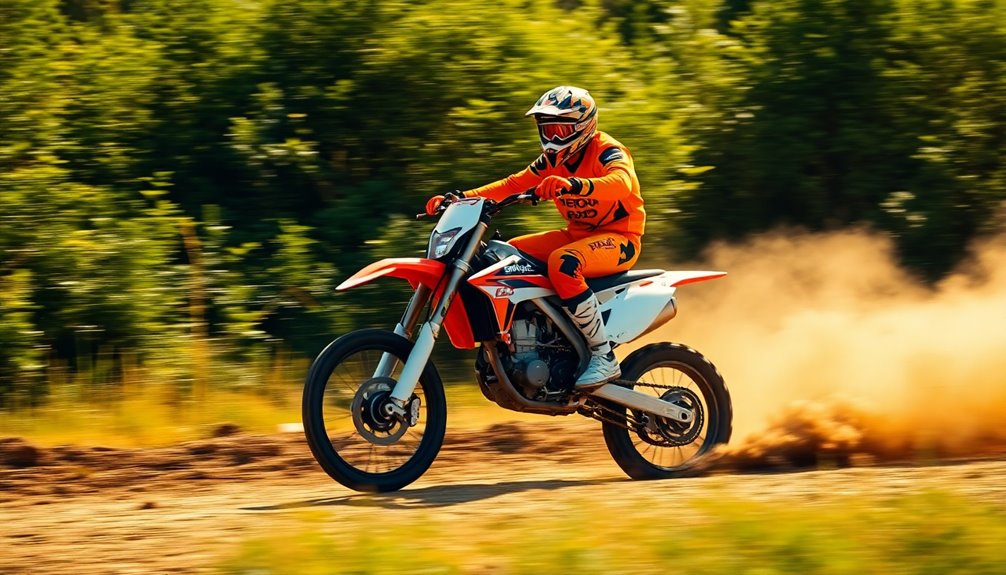
Riding comfort on long trails hinges on your body positioning and adaptability to the terrain. Standing up is crucial; it helps you maintain control and balance, especially during corners and on rough surfaces. By leaning forward and weighing the front tire, you can prevent front wheel washout, which is vital for staying safe and stable. Keep your upper body forward and legs centered on the bike for a solid stance. Maintaining balance while standing also allows for more efficient movement, which is essential for navigating challenging sections of the trail.
Gear management also plays a key role in comfort. Riding in a higher gear can make your ride smoother and more energy-efficient, while using the clutch effectively helps maintain speed without unnecessary downshifting. Avoid frequent gear changes, especially in corners, to enhance control and reduce engine wear.
Adapting to different terrains—like loose dirt, gravel, or mud—requires you to adjust your body position and gear usage. Understanding how to navigate these varied surfaces is crucial for maintaining your speed and comfort.
Whether you're tackling smooth paths or uneven trails, mastering these techniques will make your long-distance rides much more enjoyable.
Owner Insights: Real Experiences
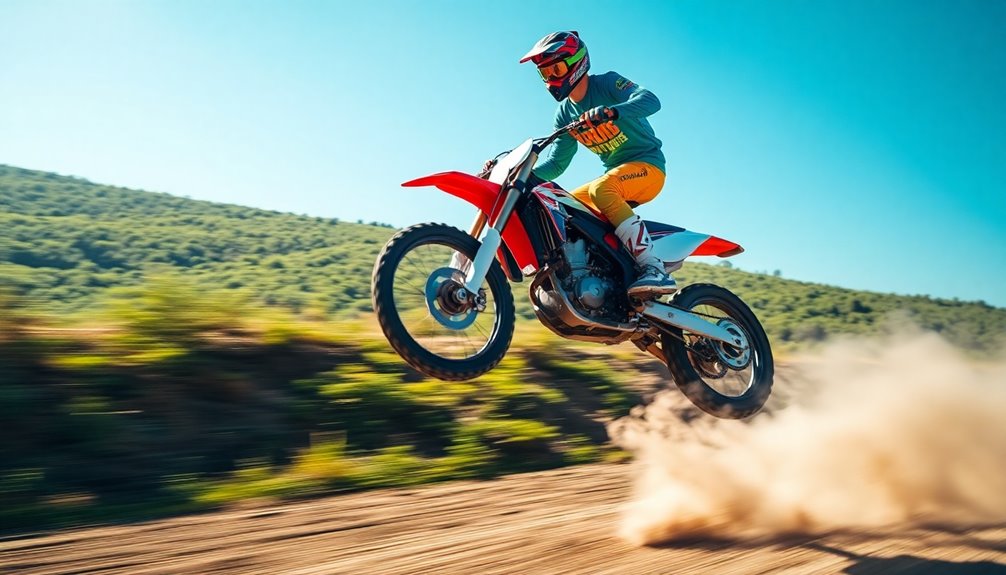
What do real owners think about the top speed of their 125cc dirt bikes? Many riders report that their bikes typically reach speeds between 55 and 60 mph, but this can vary based on several factors.
For instance, if you're heavier or less experienced, you mightn't hit those top speeds. Owners often emphasize the importance of rider skill—those who master throttle control and terrain navigation can push their bikes faster. It's also worth noting that the lightweight design of the 125cc dirt bike enhances maneuverability, allowing for better handling at higher speeds.
Terrain also plays a crucial role. Riding on flat, smooth surfaces allows for higher speeds compared to rugged off-road trails. Some owners have shared their success with modifications like engine tuning and upgraded exhaust systems, which can add a few extra mph.
Regular maintenance is another critical aspect; keeping your bike well-maintained ensures you're getting the most out of it.
Additionally, rider position can affect performance. Finding the optimal posture can help you maximize speed.
Market Share Analysis
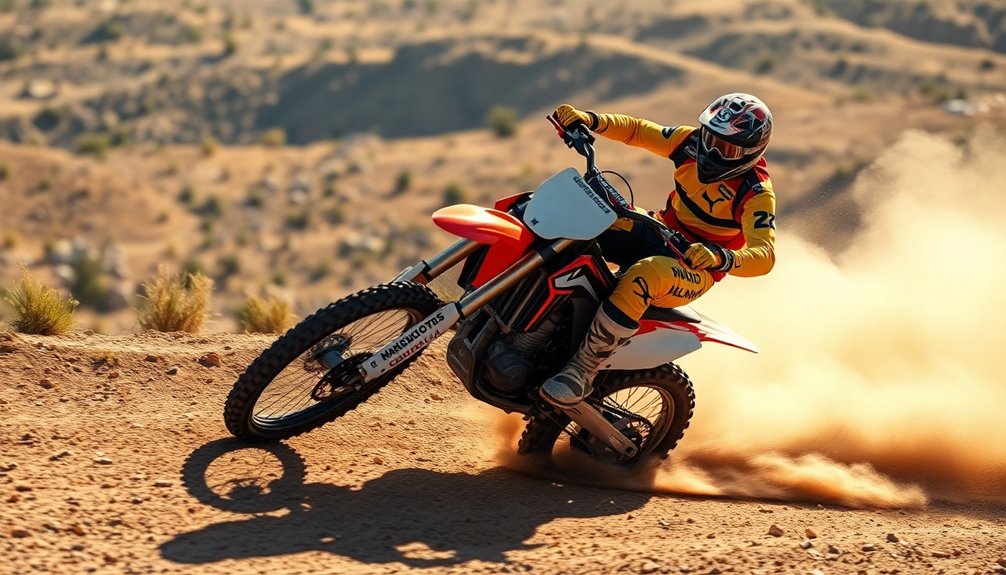
The dynamic growth of the 125cc dirt bike market reveals a thriving industry driven by off-road recreation and motorsports culture. Valued at USD 4 billion in 2022, the market is set to grow at a robust 8% CAGR, reaching an estimated USD 9.80 billion by 2029.
In the short term, you can expect growth from $7.66 billion in 2023 to $8.24 billion in 2024, fueled by increasing interest in dirt biking.
Regionally, North America holds the largest market share, while the Asia Pacific region, valued at $1.5 billion in 2022, is projected to grow at the highest CAGR through 2029. This growth is further supported by the increased demand for motocross and bike racing events.
China and India emerge as key players in this segment, with diverse offerings in motocross, enduro, and trail motorcycles.
Major companies like KTM, Honda, and Yamaha are leading the charge, continuously innovating to enhance performance and safety.
As government support for recreational infrastructure increases, the market is set for significant expansion.
The various segments, including utility and sports, cater to different needs, emphasizing the adaptability and appeal of dirt bikes across different demographics.
Performance-Boosting Aftermarket Parts
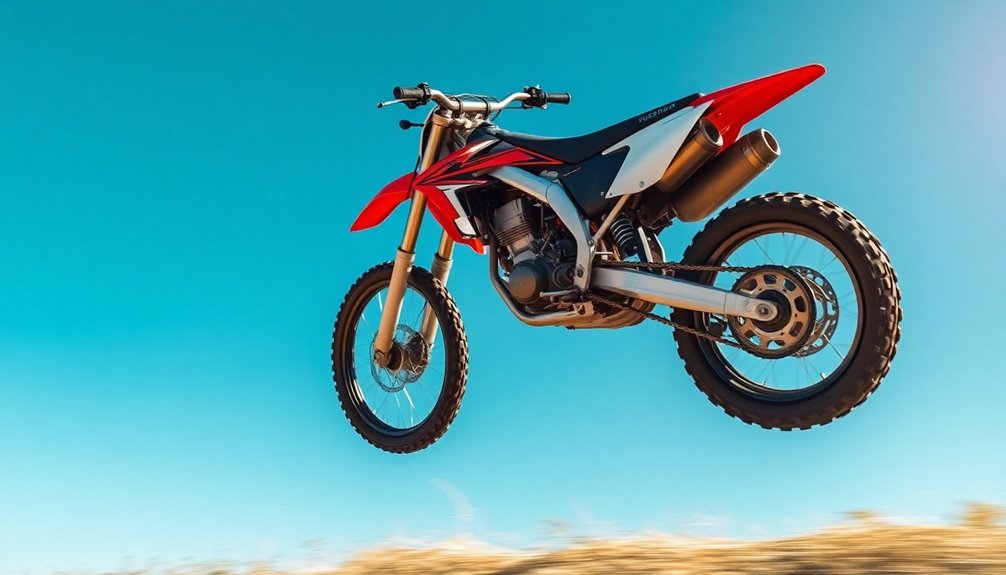
As the 125cc dirt bike market expands, many riders are looking for ways to enhance their bike's performance. One effective upgrade is the clutch, which can improve ground power and acceleration. A new clutch enhances pickup and control, leading to better overall speed. Additionally, consider upgrading to a 4-Stroke, 110cc Manual Clutch for even greater performance benefits.
Increasing your bike's compression ratio is another way to boost acceleration. For 2-stroke engines, you'll need to mill the head, while 4-stroke engines require a piston change. Just keep in mind that higher compression will need high-octane gasoline. In fact, higher compression ratios can lead to significant performance improvements, similar to those seen in Honda tuning.
Don't overlook the exhaust system either. Upgrading your muffler helps your bike breathe better and can significantly improve performance. The installation is quick and simple—usually taking about 15 minutes.
You might also consider high-performance chains and tires tailored for specific terrains. Brands like Renthal and Geomax offer products designed to maximize power transfer and traction.
Lastly, engine components from manufacturers like ProX and Bill's Pipes can provide race-tested enhancements that truly make a difference.
Cost and Stock Levels
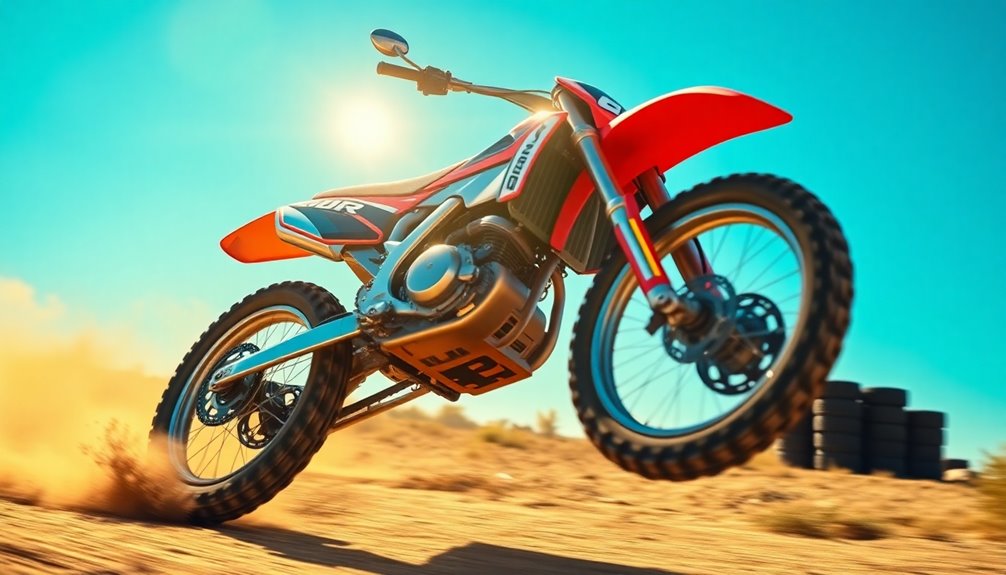
Navigating the cost and availability of 125cc dirt bikes can be crucial for riders looking to make a purchase. Typically, you can expect to spend around $3,000 to $3,200 for a new 125cc bike, with popular models like the Honda CRF125 priced at approximately $3,199 and the Suzuki DR-Z125SL ranging from $3,000 to $3,100.
Keep in mind, additional expenses such as taxes, licensing, and potential dealer-installed options can add to your overall cost. Moreover, these bikes are designed to be an ideal choice for novice riders, making them a great investment for beginners.
Availability varies by region and season. During peak riding seasons, like spring and summer, demand rises, often leading to lower stock levels. Conversely, off-seasons might see a surplus of inventory.
Major brands like Honda, Kawasaki, and KTM have wide distribution networks, so checking local dealerships or online platforms can help you find what you need.
If you're considering a used bike, prices will generally be lower, depending on the bike's condition and age.
Always factor in the initial purchase price, maintenance, and any accessories you might want for your ride, ensuring you make a well-informed decision.
Adventure-Seeking Thrill Enthusiasts
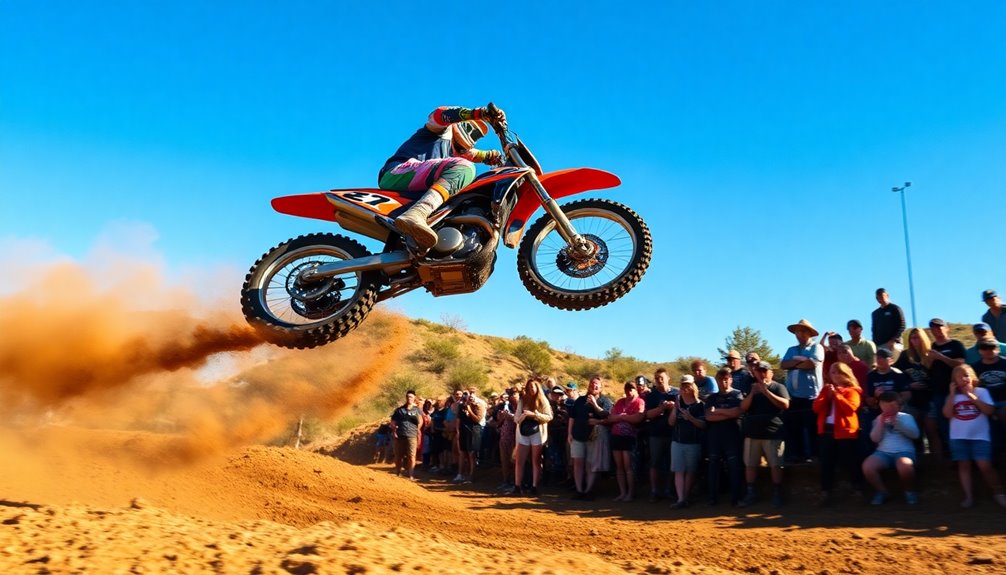
Adventure-seeking thrill enthusiasts crave the rush of speed and the excitement of tackling rugged terrains on their 125cc dirt bikes. With a top speed of 60 mph on hardpack straightaways and up to 70 mph on paved roads, these bikes deliver an exhilarating experience.
The lightweight two-stroke engines provide quick bursts of speed, perfect for those who enjoy rapid acceleration, while four-stroke engines offer smoother power delivery for better control across varied terrains. A typical 125cc dirt bike's engine delivers about half the power of a 250cc bike, making it an ideal choice for training and recreational riding.
Riding on smooth surfaces allows you to maximize your bike's speed, but rough terrain can slow you down. Your skills as a rider also play a crucial role; experience can help you reach those high speeds.
Modifications, like clutch kits and fuel tuners, can enhance your bike's performance, making it even more thrilling to ride.
The power-to-weight ratio is vital too. A lighter bike with a powerful engine accelerates faster and handles better.
Finally, tire type and condition impact traction, particularly on loose or muddy trails. So, gear up and embrace the adventure, knowing your 125cc dirt bike is designed for thrills on every ride!
Frequent Maintenance Checklist
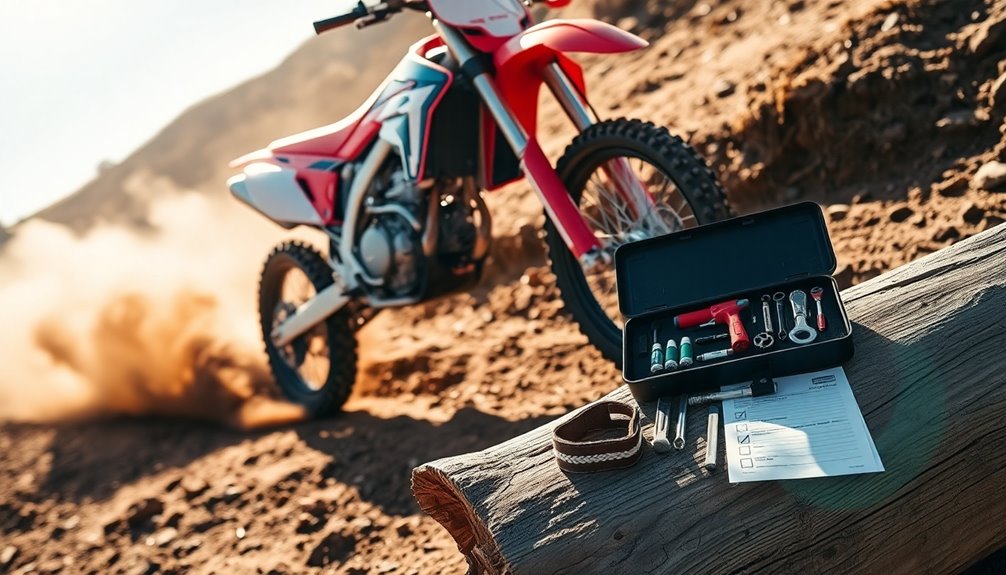
Regular maintenance is crucial for keeping your 125cc dirt bike in top shape and ensuring a safe, enjoyable ride. Start by checking for leaks, ensuring there are no oil, coolant, or brake fluid leaks before each ride. Verify your motor oil level is at the recommended mark and check the chain tension—aim for about a half-inch of movement. Additionally, make sure to monitor tire inflation to enhance your bike's performance.
Don't forget to inspect the coolant level and maintain tire pressure between 11-13 psi. After each ride, clean your bike to prevent rust and corrosion. Wash it with a pressure washer and mild detergent, then dry it with a microfiber towel. Clean or replace the air filter, and tighten any loose spokes, nuts, or bolts. Lubricate the chain as needed to keep it in good condition.
Periodically, change your engine oil every 15 hours or according to your manufacturer's specs. Inspect tires for inflation, tread, and sidewall conditions, replacing them every 1,500 to 4,500 miles. Don't overlook checking brake fluid, pads, and battery condition regularly to ensure everything's functioning well. Following this checklist will keep your dirt bike performing at its best.
Safety Gear and Equipment
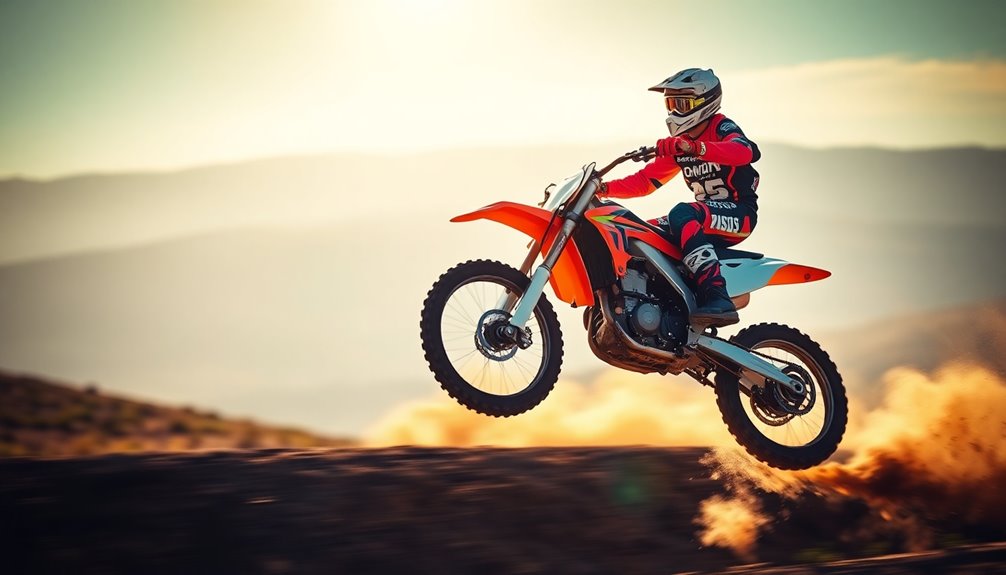
When it comes to riding a 125cc dirt bike, wearing the right safety gear is essential for protecting yourself from potential injuries. Start with a quality helmet that fits firmly and comfortably, as it's crucial for head protection in crashes.
Consider investing in a more expensive model with a strong shell and better ventilation, often featuring advanced protection systems like MIPS.
Don't forget your goggles; they protect your eyes from dust and debris, ensuring clear vision.
Boots are mandatory, offering protection for your feet and ankles from impact and burns. High-quality options also provide ankle support.
Gloves are essential as well, giving you a secure grip and protecting your hands from abrasions.
For additional body protection, knee guards or braces are vital to shield your knees from injuries while enhancing your riding technique. The importance of wearing protective gear cannot be overstated, as it significantly minimizes the risk of injury during crashes.
Chest protectors are recommended, especially for track or bush riding, as they guard your torso from impacts.
Finally, consider neck braces and body armor for comprehensive protection.
Riding pants and jerseys made from durable, breathable materials will keep you comfortable while ensuring you're safeguarded against burns and abrasions.
Prioritizing your safety gear is key to enjoying your ride!
Speed Enhancements From Modifications
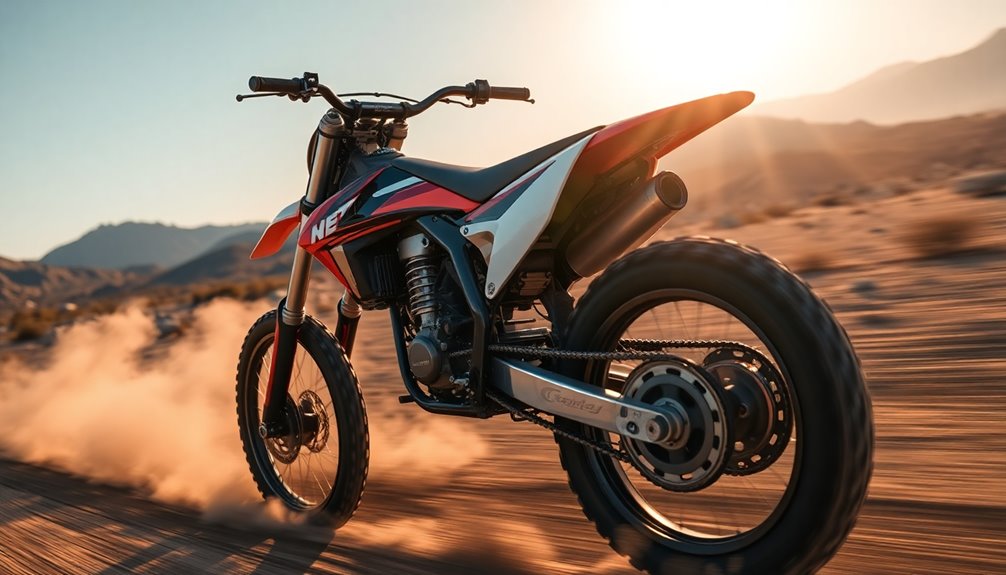
Many riders look for ways to boost the speed of their 125cc dirt bikes through modifications. One effective method is reducing weight. By removing heavy parts like fenders and opting for lightweight aftermarket components made from carbon fiber or aluminum, you can significantly improve your bike's power-to-weight ratio. A well-designed frame that evenly distributes weight also enhances speed. Reducing overall weight is the safest method to increase speed.
Enhancing engine efficiency is another key area. Upgrading to a high-flow air filter and installing exhaust system upgrades can increase horsepower and speed. Fine-tuning the fuel-air mixture with carburetor jet kits or fuel tuners like the Power Commander can optimize performance.
Don't overlook suspension and controls. Upgrading your suspension system improves stability and control at high speeds, while better controls enhance maneuverability. Adjusting suspension settings can aid performance during jumps and tight turns.
Finally, changing sprockets and tires can have a dramatic impact. Altering the gear ratio by changing sprockets can either boost top speed or acceleration. Additionally, selecting the right tires for your terrain optimizes speed and control, allowing for a more exhilarating riding experience.
Frequently Asked Questions
What Factors Affect a Dirt Bike's Top Speed?
When considering a dirt bike's top speed, you'll find several key factors at play.
Engine size and power significantly influence speed, with larger engines generally outperforming smaller ones.
Terrain matters too; flat surfaces allow for faster speeds, while rough trails hinder performance.
Your weight, along with the bike's weight, also impacts acceleration.
Lastly, modifications like tuning and gearing can enhance speed, making your ride even more thrilling.
How Do Rider Weight and Experience Influence Speed?
Rider weight and experience significantly influence your dirt bike's speed. If you're heavier, you'll load the engine more, potentially reducing your top speed.
On the flip side, if you're experienced, you'll navigate terrain better and optimize your bike's controls, enhancing your speed.
Balancing a lighter frame with skilled riding techniques can help you achieve higher speeds, especially when you adjust your bike setup to suit your weight and riding style.
Can Terrain Type Impact Dirt Bike Performance?
Absolutely, terrain type significantly impacts your dirt bike's performance.
On rocky or muddy surfaces, you'll need lower gearing for better traction and control. In contrast, smooth, hard terrains allow for higher speeds, benefiting from higher gearing.
Adjusting your bike setup, like tire pressure and suspension, according to the terrain can enhance stability and maneuverability.
What Is the Average Lifespan of a Dirt Bike Engine?
The average lifespan of a dirt bike engine varies significantly based on the type. For 4-stroke engines, you can expect around 500 hours with casual riding, while 2-strokes typically last about 100 hours.
Your riding style, maintenance habits, and terrain heavily influence this lifespan. If you ride aggressively or neglect maintenance, you'll see a faster decline in engine health.
Regular inspections and proper care can significantly extend your dirt bike's engine life.
Are There Specific Models Known for Exceptional Speed?
If you're looking for dirt bikes known for exceptional speed, check out models like the KTM 450 SX-F, which can reach 123 mph.
The Honda CRF450R offers reliable performance at 87 mph, while the Yamaha YZ450F and Suzuki RM-Z450 provide solid options around 80-85 mph.
Each bike's engine size, type, and rider skill all influence speed, so choose one that matches your riding style and experience level for the best performance.


